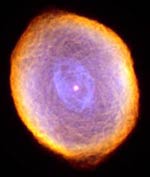The Death of Stars I: Solar-Mass Stars
Our Sun will eventually exhaust its core hydrogen and evolve off the main sequence into a red giant. After the helium flash initiates helium-burning it will move onto the horizontal branch then expand to become an AGB star. This page now explores the fate of stars of 8 solar masses or less. These stars are destined to eject planetary nebulae and end up as white dwarfs.
Planetary Nebulae
In an AGB star, if the helium fuel in the He-burning shell runs low, the outward radiation pressure drops off. As this was previously holding out the shell of hydrogen gas this shell now contracts, heats up and ignites, converting hydrogen to helium. This helium "ash" in turn falls onto the helium shell, heating it up till it is hot enough to re-ignite in a helium-shell flash, producing a thermal pulse. Increased radiation pressure now causes the hydrogen shell to expand and cool, shutting down H-shell burning.
The interval between successive thermal pulses decreases as the AGB star ages. For solar-mass stars such pulses dramatically increase the luminosity for several decades. Over time the outer layers of the AGB star are almost totally ejected and may initially appear as a circumstellar shell. The ejected cloud contains dust grains of silicates and graphite in addition to hydrogen and elements produced via nucleosynthesis reactions within the parent star. The cloud has typical expansion velocities of tens of kilometres per second.Our Sun will shed about 40% of its mass during this phase. More massive stars lose a greater percentage of their initial mass.
With the ejection of the outer layers of the star, its hot, dense core is left exposed. It is initially so hot that the intense ultraviolet radiation it emits ionises the expanding, ejected shell. This results in the cloud glowing, similar to an emission nebula. Such objects are called planetary nebulae after their initial description by Herschel in the 18th century. Through small telescopes they appear as faint discs, like a dim planet though they are not related. Planetary nebulae typically contain 0.1 - 0.2 solar masses at densities equivalent to a vacuum on Earth. Spectacular images by modern telescopes including the HST reveal a wide range of shapes that pose interesting problems for theorists to explain.
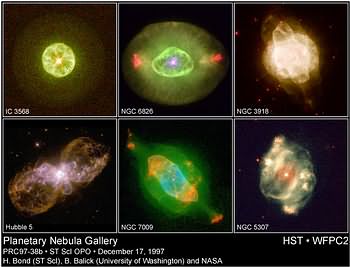
The bipolar nature of many planetary nebulae may be due to the parent star being in a binary system. Strong magnetic fields of remnant cores may also influence the shape of the nebulae. Colour of the nebulae reveals information about their composition. The characteristic blue-green colour is from the doubly-ionised oxygen emissions, OIII. Oxygen, carbon and some s-process elements ejected by AGBs and found in planetary nebulae may eventually seed the ISM for the next generation of star formation. Some of the carbon and oxygen in our bodies may have come from such nebulae, the rest probably came from supernovae explosions.
Planetary nebulae do not exist for long. An expanding shell of dust and gas may only be visible for a few 20,000 years or so before dispersing into the ISM. There are, however, over 1,500 known in our galaxy and others are visible in nearby galaxies. They are useful as one method for determining distances to these galaxies.
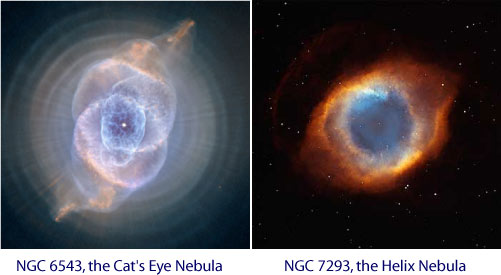
Although a planetary nebula is only short-lived, the exposed core remains. We shall now see what happens to it.
White Dwarfs
The exposed, remnant core that ionised the planetary nebula material is basically an extremely hot, dense sphere of carbon and oxygen. Any hydrogen not ejected quickly fuses via shell-burning. When initially exposed, the central star, with a temperature greater than 30,000 K may have a luminosity 100,000 × that of our Sun but it quickly fades by up to 90% within a century. The stellar remnant becomes a white dwarf or wd with a surface temperature of about 104 K.
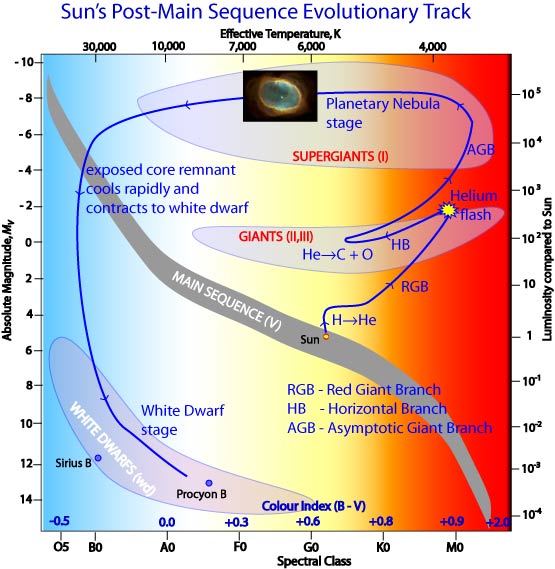
White dwarfs have unusual properties. Firstly, they are very small but the more massive white dwarfs are actually smaller than less massive ones. With their fuel used up no fusion takes place so there is no outward radiation pressure to withstand gravitational collapse. More massive stellar cores experience stronger gravitational force so actually compress more. A 0.5 solar-mass white dwarf has a radius 1.9 × that of Earth, a 1.0 solar-mass one is only 1.5 earth radii whilst a 1.3 solar-mass white dwarf 1.4 earth radii. A white dwarf is composed of carbon and oxygen ions mixed in with a sea of degenerate electrons. It is the degeneracy pressure provided by the electrons that prevents further collapse.
A white dwarf, with a mass roughly that of the Sun packed into a volume not much greater than the Earth must have an extremely high density. At 109 kg m-3 its density is one million times greater than that of water. Although its surface temperature is about 10,000 K, the core temperature may be as high as 107 K. The heat trapped within a white dwarf will gradually be radiated away by it but with its small radius, a white dwarf has only a small surface area. Heat therefore cannot escape quickly. In fact it will take tens to hundreds of billions of years for a white dwarf to radiate away its heat and cool down to a black, inert clump of carbon and degenerate electrons. As the Universe is not yet old enough for this to have happened, all the white dwarfs that have ever formed in single-star systems are still white dwarfs.
Interestingly, not only are the more massive dwarfs smaller than less massive ones, they are also less luminous for the reason explained above. Typical luminosities are less than 10-3 that of our Sun. More massive white dwarfs, having smaller surface areas but more trapped heat, take longer to cool down than lower-mass ones. As white dwarfs are so faint they are also hard to detect. We are only able to observe relatively close ones. Nonetheless white dwarfs are thought to comprise about 10% of the stars in our galaxy. Nearby examples are Sirius B and Procyon B, both of which are found in binary systems.
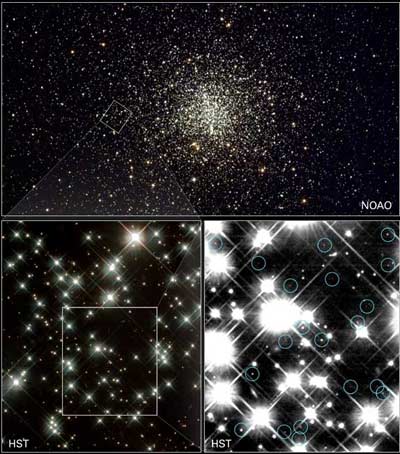
The Chandrasekhar Limit
What is the upper-mass limit for a white dwarf? We may imagine that if we increase the mass of a degenerate core it simply becomes smaller. Whilst this is true there is a limit. If the mass of the stellar remnant exceeds 1.4 solar masses then the electron degenerate pressure is insufficient to withstand the force of gravity. The core will thus continue to collapse and form either a neutron star or a black hole. Both of these are discussed in more detail on the next page. The value of 1.4 solar masses is called the Chandrasekhar limit after the Indian astrophysicist, Subrahmanyan Chandrasekhar (1910-1995). He won the 1993 Nobel Prize in Physics for this discovery and now has NASA's X-ray observatory, Chandra, named in his honour. His theoretical calculations have so far held the observational test - no white dwarfs have been found with a mass greater than 1.4 solar masses.
One point to remember about this Chandrasekhar limit is that it refers to the mass of the material in the remnant core after all other mass loss. Stars loose a lot of their mass as they evolve off the main sequence and become an AGB. The upper mass-limit for a main sequence star that will go on to form a white dwarf rather than a neutron star is not precisely known but is thought to be about 8 solar masses. A 2 solar-mass star will probably end up as a 0.7 solar-mass white dwarf. At present the lower-mass limit for any white dwarf is about 0.6 solar masses. These dwarfs form from main sequence stars slightly less than 1 solar-mass. Main sequence stars much less than this have not yet had time to evolve off the main sequence and form white dwarfs as the Universe is not yet old enough.

